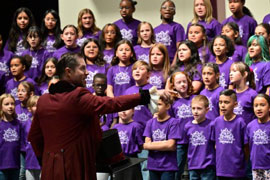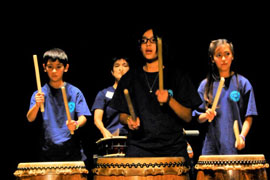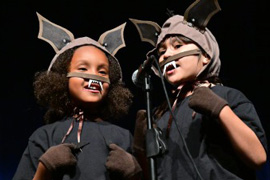Why OMA Works
Neurological Development of Children
Arts integration curriculum at each grade level is determined by brain-based research, multi-intelligence learning and the neurological development of children.
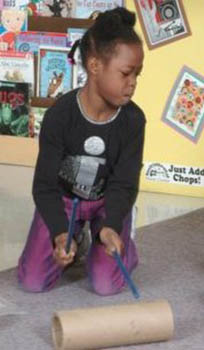 The OMA program was designed around children's neurological development. When children first come to school, they have a facility for rote memory, and many simple facts have been imprinted in their minds through songs and musical games if they have been fortunate enough to be exposed to these things. Upon entering kindergarten, the OMA curriculum will begin to use rhythm as a tool to develop memory and intellect. Although short-term memories can be stored as images, they are often stored as sounds – especially when remembering words. Short-term memory has the capacity to hold about seven pieces of information. But when related pieces are linked together, they can be stored as information and are remembered as a single piece, and thus the volume of material that can be stored increases exponentially. Information spoken in a rhythmic pattern will easily hold together as a unit. This especially holds true for second language learners, who seem to learn language far faster through elements such as singing.
The OMA program was designed around children's neurological development. When children first come to school, they have a facility for rote memory, and many simple facts have been imprinted in their minds through songs and musical games if they have been fortunate enough to be exposed to these things. Upon entering kindergarten, the OMA curriculum will begin to use rhythm as a tool to develop memory and intellect. Although short-term memories can be stored as images, they are often stored as sounds – especially when remembering words. Short-term memory has the capacity to hold about seven pieces of information. But when related pieces are linked together, they can be stored as information and are remembered as a single piece, and thus the volume of material that can be stored increases exponentially. Information spoken in a rhythmic pattern will easily hold together as a unit. This especially holds true for second language learners, who seem to learn language far faster through elements such as singing.
Verbal communication depends on utterance of a combination of sounds of various frequencies. Speech itself is a form of music. Some sounds are produced louder or softer, some with percussive sounds formed by the tongue or lips and bursts of air, others by the shape of the mouth and tongue. Rhythm is a key to proper speech and perception of speech.
Written language is a symbolic system used to translate the sounds of speech into visually perceived words that are spoken silently into the brain. Reading of words requires visual tracking and decoding of the various straight and curved lines making letters and words. Written music is a symbolic system depicting the various musical tones, timbres and rhythms. Children may learn to decipher musical symbols before reading words and this pursuit builds readiness for reading written language. Musical training of the ear increases sensitivity to and recognition of sounds and patterns which leads to oral language and literacy development. Hearing and understanding of language require memory and retention of patterns. Children from poverty often have under-developed auditory perception.
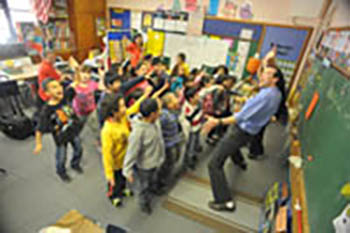 The musically engaged brain is able to think forwards and backwards, to plan ahead while retaining what has already been played. At this phase, the OMA curriculum emphasizes rhyming, sequencing, patterning and beginning composition to help build the foundation for literacy acquisition.
The musically engaged brain is able to think forwards and backwards, to plan ahead while retaining what has already been played. At this phase, the OMA curriculum emphasizes rhyming, sequencing, patterning and beginning composition to help build the foundation for literacy acquisition.
Children can repeat information they don't necessarily comprehend before they are approximately six years old (first grade). Phonics is learned through a kind of nonsense process that involves matching sounds to different objects, movements, and activities. While not linear and seemingly meaningless, this process is actually essential in developing thinking skills that will last a lifetime. The first grade classrooms will build on the perceptual development started in kindergarten and will closely link it with language development. Through the opera process students will learn that the structure of melody is shaped by the intent of the language. Opera will become the vehicle to link writing and music. Many parallels exist between music and verbal written language. A phrase in music is comparable to a sentence. A combination of several phrases parallels a paragraph. A movement in a longer work of music equates to a chapter, and the entire composition to a book or opera.
Good writing has contrast and opposition of ideas, as does excellent musical composition. An interesting story introduces the characters and then allows them to become involved in some conflict, usually leading to some resolution. In the same way, the Sonata form used by classical composers introduces several musical themes, then allows them to become involved in a considerable musical conflict in the development section, leading to the resolution in the recapitulation section. So does opera.
Just as a good reader may make a paragraph come to life with appropriate inflection and meaning, so will a great performer bring meaning and beauty to a musical phrase. Writing a sentence requires resources of vocabulary, meaning, and planning. So does a melody. The OMA first grade curriculum will focus on the acquisition of literacy development through comprehension and composition.
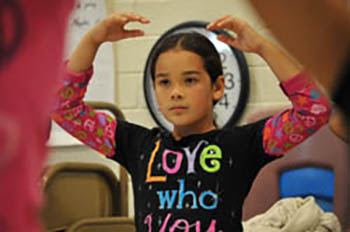 The introduction of creative movement in the second grade is a critical element in building the emotional response to music required for musical performance and understanding of music through listening. As well, appropriate physical movement to spoken language builds bridges of understanding and the internalization required for literacy. The Guggenheim Education Project in Chicago's inner city found that many students could not spell well because both the auditory stimulation provided by the teacher and the ability to track the information were faulty. However, rhythmic tools, combined with movement, almost instantly boosted the students' memory. The students will interpret and respond to a diversity of music that expands students' vocabularies, enhances their listening/viewing skills and enables them to begin thinking critically. Another outcome is a higher level of collaboration and creative problem solving as the children learn how to work with single and multiple partners and make their individual expressions compatible with the larger groups' expression and goals.
The introduction of creative movement in the second grade is a critical element in building the emotional response to music required for musical performance and understanding of music through listening. As well, appropriate physical movement to spoken language builds bridges of understanding and the internalization required for literacy. The Guggenheim Education Project in Chicago's inner city found that many students could not spell well because both the auditory stimulation provided by the teacher and the ability to track the information were faulty. However, rhythmic tools, combined with movement, almost instantly boosted the students' memory. The students will interpret and respond to a diversity of music that expands students' vocabularies, enhances their listening/viewing skills and enables them to begin thinking critically. Another outcome is a higher level of collaboration and creative problem solving as the children learn how to work with single and multiple partners and make their individual expressions compatible with the larger groups' expression and goals.
 A great spurt of neural integration occurs between ages seven and nine. The more music children are exposed to before this stage, the more deeply this stage of neural coding will assist them throughout their lives. Between second and third grades, the child commonly develops more complex skills – listening, processing visual information, and coordinating movement in the brain and into the minds. Phonics, music notation, and math link auditory centers to the left and right brains. This is called the concrete reasoning (Piaget). At this phase classrooms will use music as the vehicle of daily shared reading and writing, weekly creative movement lessons (second grade), and weekly recorder/composition classes (third grade). Competencies reinforce using creative movement and recorder/composition classes are detailed in the curriculum.
A great spurt of neural integration occurs between ages seven and nine. The more music children are exposed to before this stage, the more deeply this stage of neural coding will assist them throughout their lives. Between second and third grades, the child commonly develops more complex skills – listening, processing visual information, and coordinating movement in the brain and into the minds. Phonics, music notation, and math link auditory centers to the left and right brains. This is called the concrete reasoning (Piaget). At this phase classrooms will use music as the vehicle of daily shared reading and writing, weekly creative movement lessons (second grade), and weekly recorder/composition classes (third grade). Competencies reinforce using creative movement and recorder/composition classes are detailed in the curriculum.
From ages nine to eleven, auditory pathways undergo a further spurt, enhancing speech and listening. Choral reading, poetry, and varieties of pronunciation and dialect become important, as the brain and auditory system begin to process the voices and wisdom of the world at large. Learning to sing simple folk songs in Japanese, Swahili, German, or even regional accents such as Spanish, enable the brain to encode new sounds and thereby understand the world more fully. During this stage, the corpus callosum, the bridge between the left and right sides of the brain completes its development, allowing both hemispheres to respond to an event simultaneously.
 By age eleven, the circuits of the neurons that govern perceptual and sensory discrimination undergo a change. Children who have not had music in their education may no longer be able to develop the ability to identify pitch and rhythm after this age. At this phase, classrooms will continue to integrate music into daily shared reading and writing, history and science. Music ensembles will again conduct weekly integrated lessons based on more abstract concepts related to the core curriculum as well as language arts (fourth grade). All students will also have the opportunity to play a stringed instrument to further develop left brain/right brain intellect.
By age eleven, the circuits of the neurons that govern perceptual and sensory discrimination undergo a change. Children who have not had music in their education may no longer be able to develop the ability to identify pitch and rhythm after this age. At this phase, classrooms will continue to integrate music into daily shared reading and writing, history and science. Music ensembles will again conduct weekly integrated lessons based on more abstract concepts related to the core curriculum as well as language arts (fourth grade). All students will also have the opportunity to play a stringed instrument to further develop left brain/right brain intellect.
 The fifth graders will once again actively participate in the opera process and thematic units of study in a more sophisticated manner, engaging in both encoding and decoding functions. All students at this phase will have the discrimination skills to respond to the arts from attending professional performances in addition to pre-concert talks allowing students to understand the art form. The fifth grade curriculum will be thematically designed to integrate all subjects to enable students to create and experience subjects through inquiry based learning. The fifth grade students will connect in-depth with community arts partners to understand and experience the relevance of the arts.
The fifth graders will once again actively participate in the opera process and thematic units of study in a more sophisticated manner, engaging in both encoding and decoding functions. All students at this phase will have the discrimination skills to respond to the arts from attending professional performances in addition to pre-concert talks allowing students to understand the art form. The fifth grade curriculum will be thematically designed to integrate all subjects to enable students to create and experience subjects through inquiry based learning. The fifth grade students will connect in-depth with community arts partners to understand and experience the relevance of the arts.
Creative thinking is the most viable means to understand the structure of a discipline. Therefore, these creative opportunities set forth in the OMA curriculum will best allow students to understand and utilize the effects of arts programming. The sequential curriculum will enable both teachers and students to see the relevance and value of high quality arts in the course of other academic content areas. Students will forever have the skills in creating, performing and responding to the arts.
 We recharge educators' passion for teaching and assist them in developing techniques that fully engage the multiple intelligences of all students.
We recharge educators' passion for teaching and assist them in developing techniques that fully engage the multiple intelligences of all students.
- Arts are part of classroom instruction in all OMA schools
- Specialists, classroom teachers, and artists work together with students
- Promote community bonds with artists and organizations, including UA
Creative expression and the arts are the oldest tools humans have used to explain their world and order their reality.

